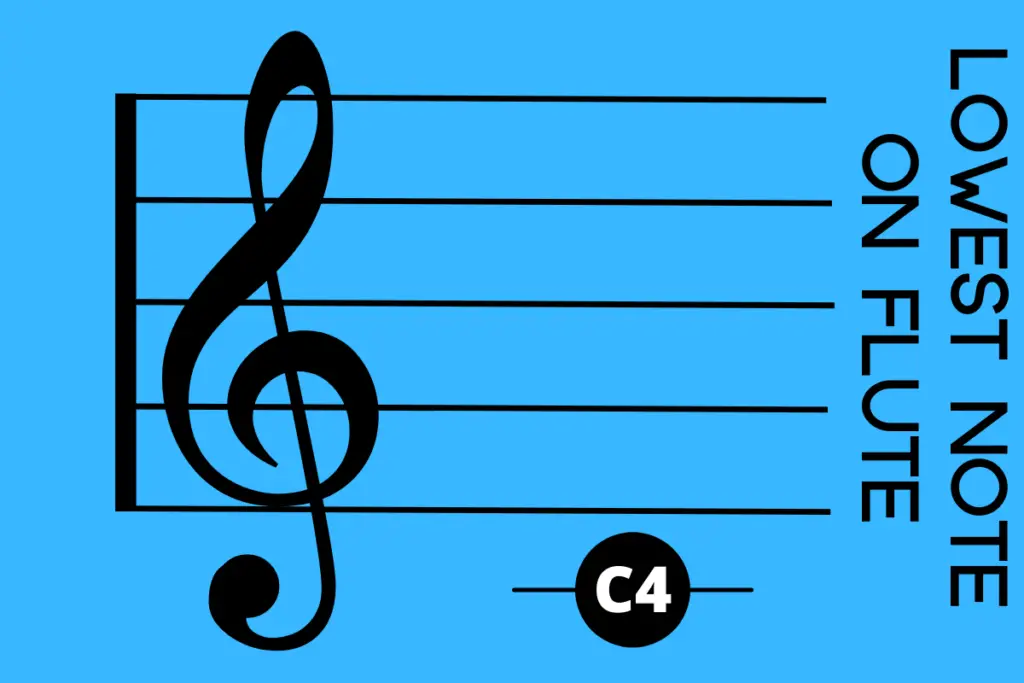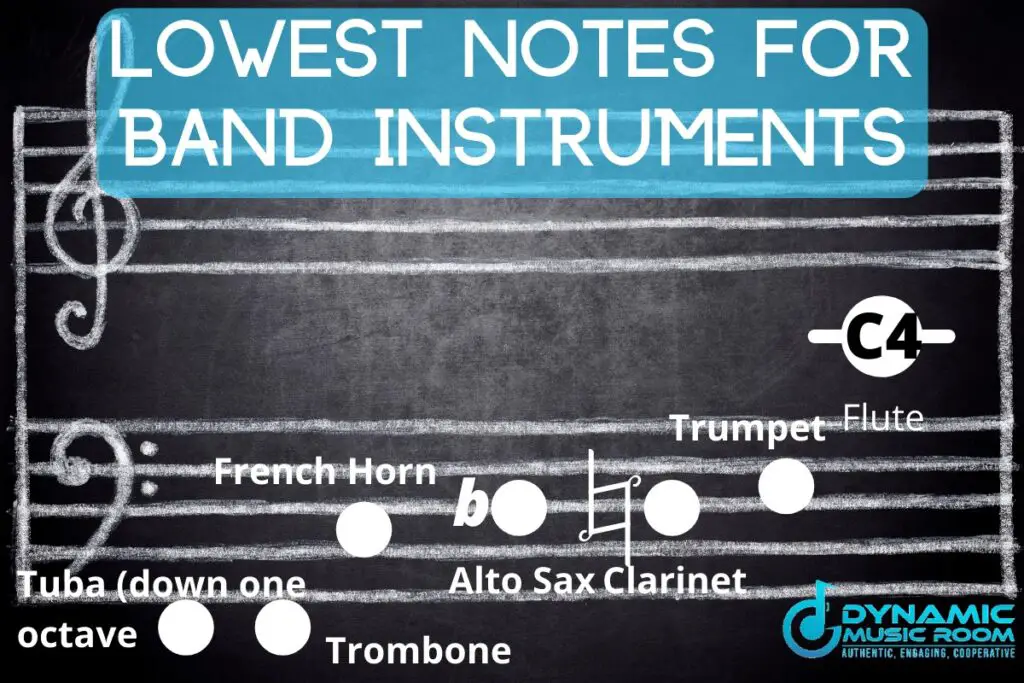In my experience working with kids and young musicians for many years, I’m always asked interesting questions about the extremes of each instrument.
One thing they always want to know is how high and low each one, such as the flute, can play.
Today, I looked at the range of flutes and decided to put the answer out there clearly once and for all.
The concert flute’s lowest note is traditionally thought of as C4 or middle C. This is the C in the middle of the piano and the grand staff. To play this note, you need to cover all tone holes and press all keys on your flute. With a longer foot joint, the flute player may bend the pitch down one half step to B3.
Playing the lowest note isn’t as simple as doing the proper fingering; let’s learn more about this topic by reading on.
Table of Contents
Lowest Note On Flute
As mentioned above, the lowest note for the concert flute is considered C4 or middle C.
Some flutes, especially those of advanced or professional quality, have longer foot joints.
With a longer foot joint, it’s possible to bend the pitch down to B3, making the lowest note B3.
Check out how long a modern flute is.
Still, this isn’t easily done in practical playing; C4 is what music composers and arrangers consider their lowest note.
Since the flute is a concert pitch instrument, they play the note they see.
When you see and finger and play C4 (one ledger line below the staff), it sounds like C4.
This is different from instruments such as trumpet, clarinet, saxophone, and french horn, which transpose their notes to make them easier to read and finger.
Here’s what it looks like.

Tips For Playing Low Notes On The Flute
When you play the lowest notes, such as C4 on the soprano flute, there are a few tips you should follow.
First, the fingering. You’ll need to cover the three primary keys with each hand (index, middle, and ring fingers).
Then, you’ll need to cover each of the pinky keys with, um, your pinkies.
Play like you usually would, and the sound may not come out or come out quite wimpy.
Consider these tips along with the fingering:
- Accept it takes practice, and don’t avoid it
- Play long tone exercises on the flute to find the correct technique for you
- Start on a note you sound good on and play long tones slowly working your way down
- Drop the corners of your mouth more to get a more ovular shape
- Tilt the flute toward your mouth
- Adjust the aim of your air column slightly against the back of the lip plate over the embouchure hole
- Think wider air
- Close your eyes and focus on the sound quality and the feel of your playing
- Loosen your embouchure slightly
This video may help you as well:
Lowest Notes For The Whole Flute Family
Of course, there are many different types of flutes (click the link to check out our guide to them), so how low can they play?
Check out this table to help you figure out the highest and lowest note for each one:
| Type Of Transverse Flutes | Lowest Note | Highest Note |
|---|---|---|
| Piccolo | D5 | C8 |
| Concert/Soprano/C | C4 | C7 |
| Alto | G3 | G6 |
| Bass flute | C3 | C6 |
| Contra-alto flute | G2 | G5 |
| Contrabass flute | C2 | C5 |
| Subcontrabass/ Double contrabass flute | C1 | C4 |
Note: You may also enjoy reading our detailed article on the full range of the flute.
Low Notes Compared To Other Band Instruments
For comparison against the other band instruments, check out this graphic of each low note on the music sheet music staff.
This graphic first appeared in the lowest note on the alto sax article.

Take note; these are the general lowest notes on each instrument.
High-level techniques have the ability to extend the range of some of these instruments, especially the brass family.
Brass instruments, such as trumpet, french horn, trombone, and tuba, have the ability to access pedal tones where they can play much lower than their standard range.
Also, keep in mind, just because an instrument can play that low doesn’t mean it should.
For example, the clarinet plays almost as low as the saxophone, but it won’t sound as strong.
This woodwind instrument can play down to C4, but it has an airy tone quality.
The rich tone of this wind instrument comes from the upper register.
FAQ
What is the note range of a flute?
The flute range is from C4-C7. All types of the flute have a functional range of three octaves.
Functional range means this is what we consider the instrument usually capable of in the hands of the average good player. Professionals typically have access to greater ranges.
What’s the highest note a flute can play?
It’s widely considered the highest note a flute can play is C7. As mentioned above, it’s possible to play higher with advanced techniques.
These usually involve a unique combination of odd flute fingerings and aiming a very tight air column across the embouchure hole at the exact right spot.
Unfortunately, it doesn’t get much clearer than this. It takes individual practice and experimentation.
Lessons with a professional would help as well.
Can a flute play in any key?
A flute can play in any key. The idea they can only play in one key comes from one of the names of the soprano flute: the flute in C or C flute.
If you didn’t know any better, it might lead you to think it only plays in the key of C.
With the combination of 16 keys and even more tone holes, the flute can access any note and play in any key.
The name speaks to the “base” note the instrument is built around. This note is C. In fact, this is why the lowest note is C.
For G flutes (such as the alto), the base tone is G.
Note: I use the word “base” instead of “bass” in this instance because I’m talking about the note the instrument is built around, not necessarily the lowest note.
Although, in this case, it’s the same. The best term to use is the “fundamental note.”
Can you play chords on the flute?
Chords are impossible to play on the flute in the traditional and technical sense.
Chords need three or more notes played at the exact same time.
A flute player may access multi-phonics which involve two notes by singing and playing or other odd techniques, but not three notes.
A flutist may also break up the notes of a chord and play them in quick succession to get a similar feel of a chord.
This is called outlining a chord.
Which flute is easiest to play?
The most accessible type of flute to play is the soprano flute.
This is the standard flute, and it goes by many names, including:
- Standard flute
- Concert flute
- Soprano flute
- C flute
- Western concert flute
- German flute

